Joomla è un sistema di gestione dei contenuti open source utilizzato per la pubblicazione di applicazioni e siti Web online. È scritto in PHP e utilizza MySQL/MariaDB come back-end del database. Si tratta di un framework di applicazioni Web model-view-controller predisposto per dispositivi mobili, facile da usare e costruito su un framework di applicazioni web. Joomla viene fornito con un sacco di funzionalità e design che lo rendono una buona scommessa per la creazione di siti professionali.
In questo tutorial, ti mostreremo come installare Joomla CMS con Apache e proteggere con Let's Encrypt SSL su Ubuntu 20.04.
Prerequisiti
- Un server che esegue Ubuntu 20.04 con 2 GB di RAM.
- Un nome di dominio valido puntato al tuo server.
- Sul tuo server è configurata una password di root.
Installa il server LAMP
Innanzitutto, dovrai installare il server web Apache, MariaDB, PHP e altre estensioni PHP nel tuo sistema. Puoi installarli usando il seguente comando:
apt-get install apache2 mariadb-server php7.4 libapache2-mod-php7.4 php7.4-cli php7.4-mysql php7.4-json php7.4-opcache php7.4-mbstring php7.4-intl php7.4-xml php7.4-gd php7.4-zip php7.4-curl php7.4-xmlrpc unzip -y
Una volta installati tutti i pacchetti, modifica il file php.ini e modifica alcune impostazioni.
nano /etc/php/7.4/apache2/php.ini
Modifica i seguenti valori:
memory_limit = 512M upload_max_filesize = 256M post_max_size = 256M output_buffering = Off max_execution_time = 300 date.timezone = Asia/Kolkata
Salva e chiudi il file una volta terminato.
Crea un database
Per prima cosa, proteggi l'installazione di MariaDB e imposta la password root di MariaDB con il seguente comando:
mysql_secure_installation
Rispondi a tutte le domande come mostrato di seguito:
Enter current password for root (enter for none): Set root password? [Y/n] Y New password: Re-enter new password: Remove anonymous users? [Y/n] Y Disallow root login remotely? [Y/n] Y Remove test database and access to it? [Y/n] Y Reload privilege tables now? [Y/n] Y
Quindi, accedi alla shell MariaDB con il seguente comando:
mysql -u root -p
Fornisci la tua password di root MariaDB quando richiesto, quindi crea un database e un utente per Joomla con il seguente comando:
MariaDB [(none)]> CREATE DATABASE joomladb CHARACTER SET utf8mb4 COLLATE utf8mb4_general_ci;
MariaDB [(none)]> GRANT ALL ON joomladb.* TO 'joomla'@'localhost' IDENTIFIED BY 'password';
Quindi, svuota i privilegi ed esci dalla shell MariaDB con il seguente comando:
MariaDB [(none)]> FLUSH PRIVILEGES;
MariaDB [(none)]> EXIT;
Scarica e installa Joomla
Innanzitutto, scarica l'ultima versione di Joomla dal suo sito Web ufficiale con il seguente comando:
wget https://downloads.joomla.org/cms/joomla3/3-9-18/Joomla_3-9-18-Stable-Full_Package.zip
Una volta completato il download, decomprimere il file scaricato nella directory principale web di Apache con il seguente comando:
unzip Joomla_3-9-18-Stable-Full_Package.zip -d /var/www/html/joomla
Quindi, cambia la proprietà della directory di Joomla in www-data con il seguente comando:
chown -R www-data:www-data /var/www/html/joomla
Una volta terminato, puoi procedere al passaggio successivo.
Configura Apache per Joomla
Quindi, crea un nuovo file di configurazione dell'host virtuale Apache per servire Joomla.
nano /etc/apache2/sites-available/joomla.conf
Aggiungi il seguente contenuto:
<VirtualHost *:80>
ServerName joomla.linuxbuz.com
DirectoryIndex index.html index.php
DocumentRoot /var/www/html/joomla
ErrorLog ${APACHE_LOG_DIR}/joomla-error.log
CustomLog ${APACHE_LOG_DIR}/joomla-access.log combined
<Directory /var/www/html/joomla>
Options FollowSymLinks
AllowOverride All
Require all granted
</Directory>
</VirtualHost>
Salvare e chiudere il file, quindi abilitare l'host virtuale Apache e riavviare il servizio Apache utilizzando il seguente comando:
a2ensite joomla
systemctl restart apache2
Una volta terminato, puoi procedere al passaggio successivo.
Proteggi Joomla con Let's Encrypt SSL
Innanzitutto, dovrai installare il client Certbot per installare e gestire Let's Encrypt SSL. Puoi installarlo con il seguente comando:
apt-get install certbot python3-certbot-apache -y
Una volta installato Certbot, esegui il seguente comando per scaricare e installare Let's Encrypt SSL per il tuo sito web:
certbot --apache -d joomla.linuxbuz.com
Ti verrà chiesto di fornire il tuo indirizzo email e di accettare i termini del servizio come mostrato di seguito:
Saving debug log to /var/log/letsencrypt/letsencrypt.log Plugins selected: Authenticator apache, Installer apache Enter email address (used for urgent renewal and security notices) (Enter 'c' to cancel): [email protected] - - - - - - - - - - - - - - - - - - - - - - - - - - - - - - - - - - - - - - - - Please read the Terms of Service at https://letsencrypt.org/documents/LE-SA-v1.2-November-15-2017.pdf. You must agree in order to register with the ACME server at https://acme-v02.api.letsencrypt.org/directory - - - - - - - - - - - - - - - - - - - - - - - - - - - - - - - - - - - - - - - - (A)gree/(C)ancel: A - - - - - - - - - - - - - - - - - - - - - - - - - - - - - - - - - - - - - - - - Would you be willing to share your email address with the Electronic Frontier Foundation, a founding partner of the Let's Encrypt project and the non-profit organization that develops Certbot? We'd like to send you email about our work encrypting the web, EFF news, campaigns, and ways to support digital freedom. - - - - - - - - - - - - - - - - - - - - - - - - - - - - - - - - - - - - - - - - (Y)es/(N)o: Y Obtaining a new certificate Performing the following challenges: http-01 challenge for joomla.linuxbuz.com Enabled Apache rewrite module Waiting for verification... Cleaning up challenges Created an SSL vhost at /etc/apache2/sites-available/joomla-le-ssl.conf Enabled Apache socache_shmcb module Enabled Apache ssl module Deploying Certificate to VirtualHost /etc/apache2/sites-available/joomla-le-ssl.conf Enabling available site: /etc/apache2/sites-available/joomla-le-ssl.conf
Quindi, seleziona se reindirizzare o meno il traffico HTTP su HTTPS come mostrato di seguito:
Please choose whether or not to redirect HTTP traffic to HTTPS, removing HTTP access. - - - - - - - - - - - - - - - - - - - - - - - - - - - - - - - - - - - - - - - - 1: No redirect - Make no further changes to the webserver configuration. 2: Redirect - Make all requests redirect to secure HTTPS access. Choose this for new sites, or if you're confident your site works on HTTPS. You can undo this change by editing your web server's configuration. - - - - - - - - - - - - - - - - - - - - - - - - - - - - - - - - - - - - - - - - Select the appropriate number [1-2] then [enter] (press 'c' to cancel): 2
Digita 2 e premi Invio per completare l'installazione come mostrato di seguito.
Redirecting vhost in /etc/apache2/sites-enabled/joomla.conf to ssl vhost in /etc/apache2/sites-available/joomla-le-ssl.conf - - - - - - - - - - - - - - - - - - - - - - - - - - - - - - - - - - - - - - - - Congratulations! You have successfully enabled https://joomla.linuxbuz.com You should test your configuration at: https://www.ssllabs.com/ssltest/analyze.html?d=joomla.linuxbuz.com - - - - - - - - - - - - - - - - - - - - - - - - - - - - - - - - - - - - - - - - IMPORTANT NOTES: - Congratulations! Your certificate and chain have been saved at: /etc/letsencrypt/live/joomla.linuxbuz.com/fullchain.pem Your key file has been saved at: /etc/letsencrypt/live/joomla.linuxbuz.com/privkey.pem Your cert will expire on 2020-08-19. To obtain a new or tweaked version of this certificate in the future, simply run certbot again with the "certonly" option. To non-interactively renew *all* of your certificates, run "certbot renew" - Your account credentials have been saved in your Certbot configuration directory at /etc/letsencrypt. You should make a secure backup of this folder now. This configuration directory will also contain certificates and private keys obtained by Certbot so making regular backups of this folder is ideal. - If you like Certbot, please consider supporting our work by: Donating to ISRG / Let's Encrypt: https://letsencrypt.org/donate Donating to EFF: https://eff.org/donate-le - We were unable to subscribe you the EFF mailing list because your e-mail address appears to be invalid. You can try again later by visiting https://act.eff.org.
A questo punto, il tuo sito Web Joomla è protetto con Let's Encrypt SSL. Ora puoi procedere al passaggio successivo.
Accedi a Joomla CMS
Ora apri il tuo browser web e digita l'URL https://joomla.linuxbuz.com. Verrai reindirizzato alla procedura guidata di installazione basata sul Web di Joomla:
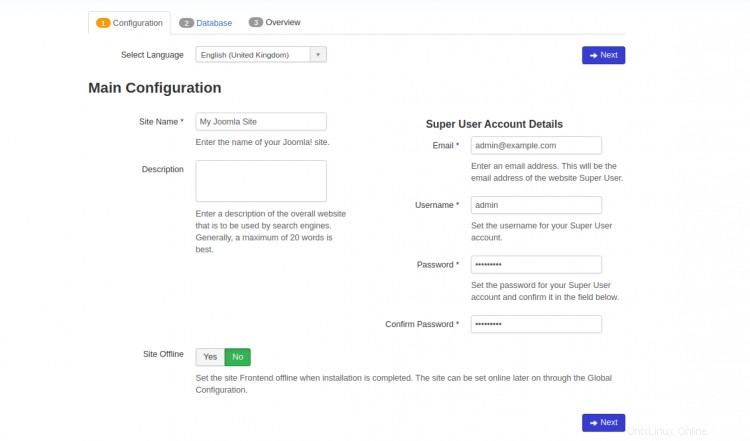
Fornisci il nome del sito, l'e-mail dell'amministratore, la password e fai clic su Avanti pulsante. Dovresti vedere la procedura guidata di configurazione del database:
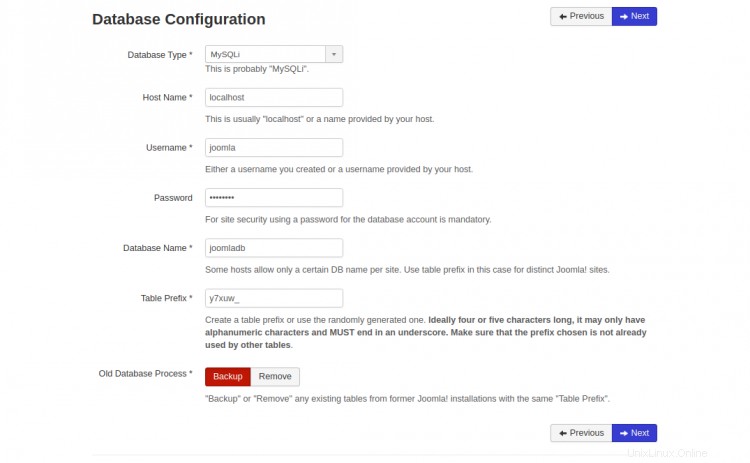
Fornisci il nome del tuo database Joomla, il nome utente del database, la password e fai clic su Avanti pulsante. Dovresti vedere la pagina di finalizzazione di Joomla:
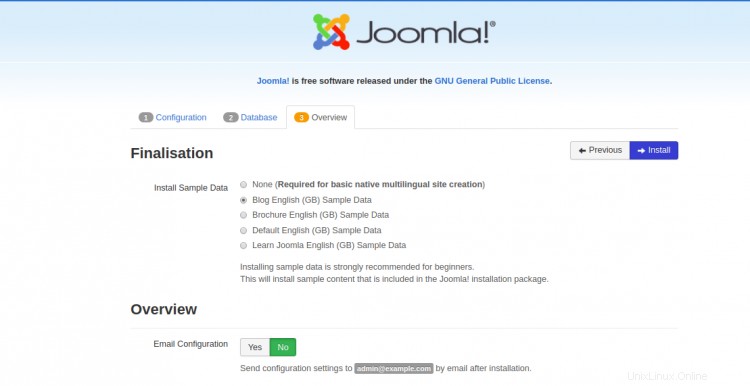
Seleziona l'opzione desiderata e fai clic su Installa pulsante. Dovresti vedere la seguente pagina:
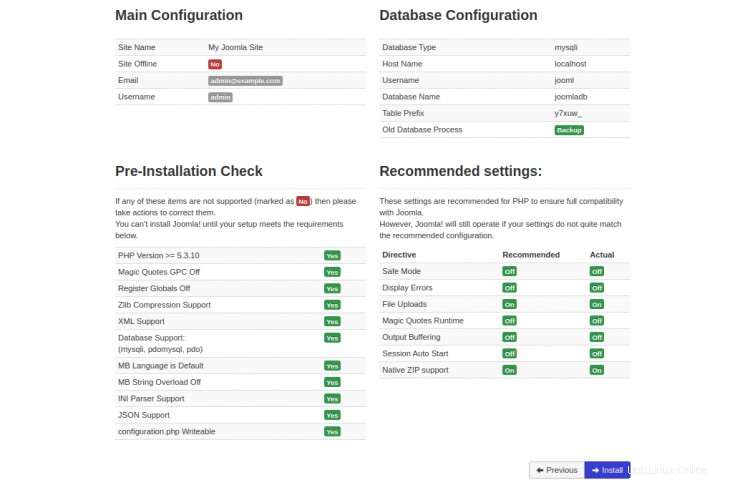
Rivedi tutte le configurazioni e fai clic sul pulsante Installa. Una volta installato Joomla, dovresti vedere la seguente schermata:
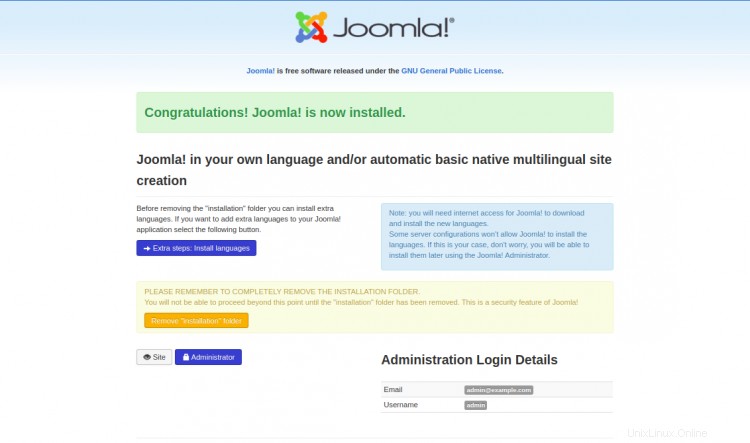
Ora rimuovi la directory di installazione e fai clic su Amministratore pulsante. Dovresti vedere la pagina di accesso di Joomla:
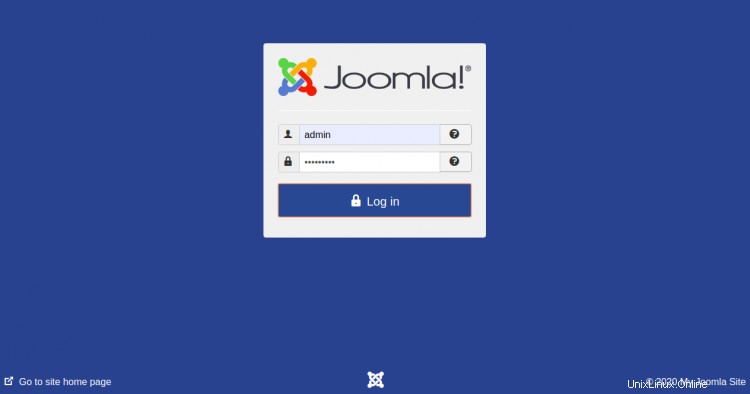
Fornisci il tuo nome utente Joomla, la password e fai clic sul Log dentro pulsante. Dovresti vedere la dashboard di Joomla nella pagina seguente:

Puoi anche accedere al tuo sito web Joomla visitando l'URL https://joomla.linuxbuz.com. Dovresti vedere il tuo sito web Joomla nella seguente pagina:
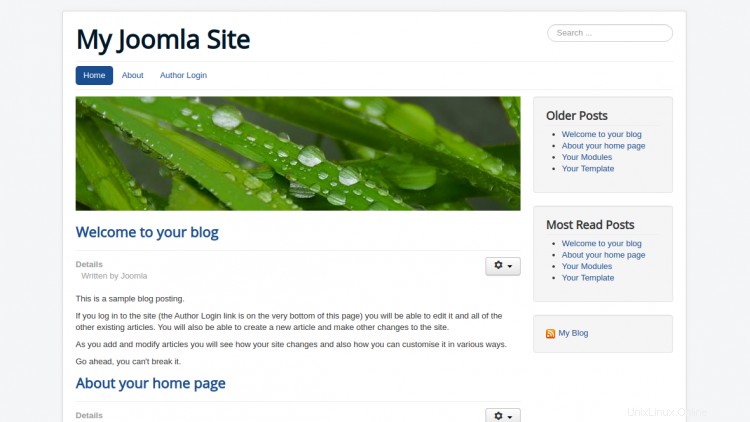
Conclusione
Congratulazioni! hai installato e protetto con successo Joomla con Let's Encrypt su Ubuntu 20.04. Ora puoi creare facilmente il tuo negozio eCommerce, sito web personale, sito social o blog. Sentiti libero di chiedermi se hai domande.